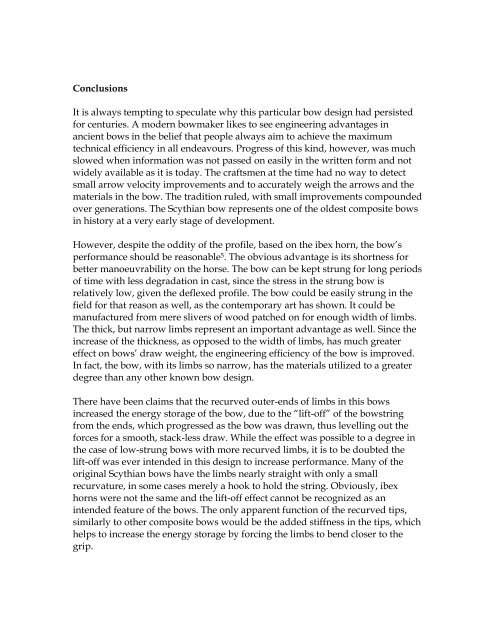You also want an ePaper? Increase the reach of your titles
YUMPU automatically turns print PDFs into web optimized ePapers that Google loves.
Conclusions<br />
It is always tempting to speculate why this particular bow design had persisted<br />
for centuries. A modern bowmaker likes to see engineering advantages in<br />
ancient bows in the belief that people always aim to achieve the maximum<br />
technical efficiency in all endeavours. Progress of this kind, however, was much<br />
slowed when information was not passed on easily in the written form and not<br />
widely available as it is today. The craftsmen at the time had no way to detect<br />
small arrow velocity improvements and to accurately weigh the arrows and the<br />
materials in the bow. The tradition ruled, with small improvements compounded<br />
over generations. The Scythian bow represents one of the oldest composite bows<br />
in history at a very early stage of development.<br />
However, despite the oddity of the profile, based on the ibex horn, the bow‟s<br />
performance should be reasonable 5 . The obvious advantage is its shortness for<br />
better manoeuvrability on the horse. The bow can be kept strung for long periods<br />
of time with less degradation in cast, since the stress in the strung bow is<br />
relatively low, given the deflexed profile. The bow could be easily strung in the<br />
field for that reason as well, as the contemporary art has shown. It could be<br />
manufactured from mere slivers of wood patched on for enough width of limbs.<br />
The thick, but narrow limbs represent an important advantage as well. Since the<br />
increase of the thickness, as opposed to the width of limbs, has much greater<br />
effect on bows‟ draw weight, the engineering efficiency of the bow is improved.<br />
In fact, the bow, with its limbs so narrow, has the materials utilized to a greater<br />
degree than any other known bow design.<br />
There have been claims that the recurved outer-ends of limbs in this bows<br />
increased the energy storage of the bow, due to the “lift-off” of the bowstring<br />
from the ends, which progressed as the bow was drawn, thus levelling out the<br />
forces for a smooth, stack-less draw. While the effect was possible to a degree in<br />
the case of low-strung bows with more recurved limbs, it is to be doubted the<br />
lift-off was ever intended in this design to increase performance. Many of the<br />
original Scythian bows have the limbs nearly straight with only a small<br />
recurvature, in some cases merely a hook to hold the string. Obviously, ibex<br />
horns were not the same and the lift-off effect cannot be recognized as an<br />
intended feature of the bows. The only apparent function of the recurved tips,<br />
similarly to other composite bows would be the added stiffness in the tips, which<br />
helps to increase the energy storage by forcing the limbs to bend closer to the<br />
grip.


